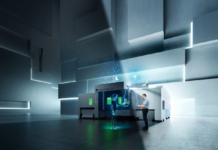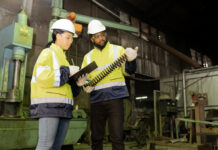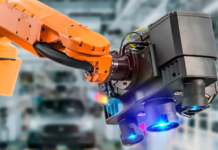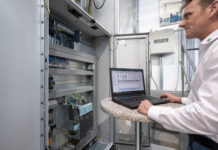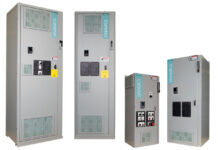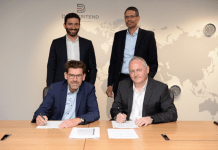Better Control of Welding
H. Peterson Finds up to 30% improvement in time savings reported.
Robert H. Peterson Company, City of Industry, Calif. has produced  premium-quality Fire Magic gas grills and Real-Fyre gas logs for American homes since 1937 that are sold domestically and internationally at specialty dealers of patio, barbeque and fireplace fixtures and furnishings. Over the years, the company has grown steadily and their commitment to quality and craftsmanship has remained unchanged, despite considerable foreign and domestic competition, the changing demands in public taste and the constant challenge of product innovations.
premium-quality Fire Magic gas grills and Real-Fyre gas logs for American homes since 1937 that are sold domestically and internationally at specialty dealers of patio, barbeque and fireplace fixtures and furnishings. Over the years, the company has grown steadily and their commitment to quality and craftsmanship has remained unchanged, despite considerable foreign and domestic competition, the changing demands in public taste and the constant challenge of product innovations.
What has changed is the company’s approach to manufacturing, where the major shift is from single station operations with one man/one machine orientation, to more automation, both in the fabrication and assembly done here. At this facility, which comprises nearly 230,000 square feet of manufacturing area, every facet of the manufacturing process is housed, including sheet metal fabrication, laser cutting, robotic welding, die and press brake forming, grinding, polishing, assembly, testing, packaging, and distribution.
Integrating Automation
Recently, as part of the continuous flow manufacturing line for its new Echelon and Aurora gas grills, R.H. Peterson looked to Contour-Arc, Inc., a local integrator of robotic and automated welding systems for a custom CNC Controlled Spot Welding System. This new custom built machine was not only needed to automate the precise and challenging welding of large, cumbersome stainless steel grill firebox assemblies, but was also required to integrate directly into the company’s continuous flow line of fabrication, assembly, test and packaging operations. Contour-Arc reviewed the company’s requirements and brought its 30 years of expertise in automated welding and factory automation to the task.
The CNC Spot Welding System Contour developed consists of several major components, built around the Siemens SINUMERIK 802D CNC 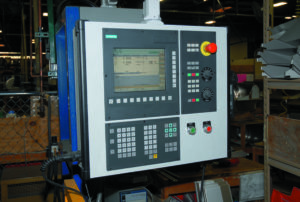 control, using three axes, X/Y/C, of coordinated motion, and the Miyachi Unitek IS-120B Inverter Spot Welding Power Supply. The system was designed with four independent welding stations attached to two oscillating rotary index tables placed side-by-side.
control, using three axes, X/Y/C, of coordinated motion, and the Miyachi Unitek IS-120B Inverter Spot Welding Power Supply. The system was designed with four independent welding stations attached to two oscillating rotary index tables placed side-by-side.
According to Contour-Arc, Inc. president Steven Pfahl, this configuration allows the operator to safely load the fixtures on one side of the index tables while the machine is welding on the other side, thereby maximizing the system’s production time and minimizing machine idle time. In addition to the three motion axes and the two rotary index tables, the SINUMERIK 802D controls and monitors all functions of the machine, including the spot welding process. To facilitate the different material thicknesses of these firebox assemblies, the CNC interfaces seamlessly with the Miyachi IS-120B power supply so the programmer can call up any number of pre-programmed weld schedules stored in the weld controller and use them wherever needed.
A typical Fire Magic Grill firebox assembly has 50 spot-welds on each side of the firebox, with each fixture holding both sides 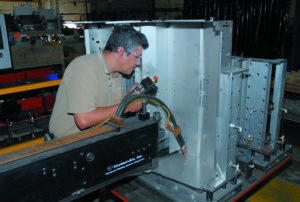 simultaneously. The typical welding program can be written in less than one hour, according to Pfahl. Siemens also provided on-site training at the end-user’s facility to help train the company’s operator personnel on writing the specific programs using the remote pendant and at the control panel, plus backing up and storing machine data that are stored on the compact flash card or onto the customer’s server via the control’s Ethernet port.
simultaneously. The typical welding program can be written in less than one hour, according to Pfahl. Siemens also provided on-site training at the end-user’s facility to help train the company’s operator personnel on writing the specific programs using the remote pendant and at the control panel, plus backing up and storing machine data that are stored on the compact flash card or onto the customer’s server via the control’s Ethernet port.
Custom Part-Holding
To complete this turnkey system, Contour-Arc designed and built custom part-holding fixtures that were needed to assure the  combined time of part loading and unloading would be less than the weld cycle time. The firebox comprises several irregular shaped sheet metal components, with the welding being done completely around the perimeter of the assembly.
combined time of part loading and unloading would be less than the weld cycle time. The firebox comprises several irregular shaped sheet metal components, with the welding being done completely around the perimeter of the assembly.
Because the shape of the assembly is such that mechanical clamps would either interfere with the welding head or with the loading and removing of the finished assembly from the fixture, vacuum clamping was chosen to hold the components in the fixtures.
”The advantage of the vacuum clamping system is that the operator can load and unload the fixtures in a matter of seconds,” says Steve Pfahl, “and nothing gets in the way of the machine’s welding head and electrode. This allows us to run the machine at its maximum speed. We also programmed the CNC to monitor vacuum sensors placed in the fixtures, so if the vacuum level falls below the minimum set-point, machine motion will stop and an alarm will display on the control panel.”
Saving Time
All the fixtures on the machine are quick-change style with locating pins and quick disconnect electrical and vacuum fittings, plus the system’s configuration allows the fixtures to be changed on one index table while the robot is welding at the other, again reducing system idle time and maximizing the production on each shift. So far, improvements in overall time savings up to 30% have been reported by the customer, R.H. Peterson.
 “From an OEM standpoint, due to the nature of the custom machine building business,” notes Mr. Pfahl on the control integration process, “we needed a complete single-source CNC package, including the hardware, drives, motors and programming software, that was extremely versatile, yet easy to integrate. We found exactly what we were seeking with Siemens. For many years, we’d built our machines using another brand of CNC control and, by comparison, setting up the 802D using the Siemens Toolbox Software Package was very easy to learn and navigate.”
“From an OEM standpoint, due to the nature of the custom machine building business,” notes Mr. Pfahl on the control integration process, “we needed a complete single-source CNC package, including the hardware, drives, motors and programming software, that was extremely versatile, yet easy to integrate. We found exactly what we were seeking with Siemens. For many years, we’d built our machines using another brand of CNC control and, by comparison, setting up the 802D using the Siemens Toolbox Software Package was very easy to learn and navigate.”
Pfahl also noted the on-site OEM training provided by Siemens included hands-on programming of the CNC’s Servo Motor Drives, internal PLC, and I/O control.
“The 802D control had everything we needed for this project, including Profibus connection between the CNC and I/O boards, as well as the Siemens Mini-Handheld, which is a portable remote programming pendant. This machine’s X-Axis has 120 inches of linear travel and the Mini-Handheld allows the programmer to write the program point-to-point by jogging the various axes into position and then recording those locations using the pendant rather than at the control panel, thereby saving the programmer time and motion.
“The machine’s large footprint also required us to place a remote operator station a considerable distance away from the CNC cabinet and closer to where the operator will be running the machine in production. The operator start station is a pedestal-mounted operator console with a series of pushbuttons, rotary switches and pilot lamps, all connected to the CNC’s I/O Board.
“The Profibus connection allowed us to remotely mount a second I/O board inside the operator console and connect all the machine controls to that board, rather than running all that wiring back to the main control cabinet. It reduced the amount of wiring between the control and operator station by over 90 percent.”
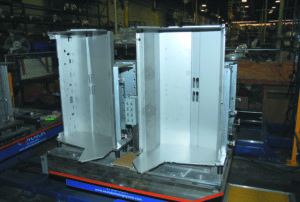 “On the floor at R.H. Peterson, we run eight different grill sizes of three different models,” explains Jon Bridgwater, that company’s senior vice president. “Once we set up the four programs needed, no additional programming must be performed. After we program the CNC, it is fully automated in process. We also spent a considerable amount of design time on standardizing the part holding fixtures, so that minimal or no changeover would be needed, when going from one size to another.
“On the floor at R.H. Peterson, we run eight different grill sizes of three different models,” explains Jon Bridgwater, that company’s senior vice president. “Once we set up the four programs needed, no additional programming must be performed. After we program the CNC, it is fully automated in process. We also spent a considerable amount of design time on standardizing the part holding fixtures, so that minimal or no changeover would be needed, when going from one size to another.
“As a result, the fixtures have no moving parts or mechanical clamping devices that might interfere with the spot welding head, as the assembly’s components are held in place with vacuum cups. This system has allowed us complete flexibility in the models, sizes, and quantities we can run at any time. This is the ultimate in lean manufacturing.”
He further cites that the machine’s control, the Siemens SINUMERIK 802D solution line CNC, is the key component in the system’s overall performance. Regardless of the components run in any cycle, the CNC can accurately determine and execute the angle and depth of the welding arm’s articulation, resulting in non-stop production with no compromise of quality. Bridgwater noted, “There is simply no comparison between the way we did things in the past and this new system.”
Committed to Vertical Integration
The company has an historical commitment to vertical integration in its manufacturing and, as Jon Bridgwater observes, “This commitment gives us more control over our own destiny, as we remain a self-reliant and independent operation in our marketplace.”
In addition to the Fire Magic gas grills, R.H. Peterson also produces the popular American Outdoor Grill line and Real-Fyre line of vented and unvented gas logs for home fireplaces. To maintain its competitive advantage over the competition, the company has totally integrated manufacturing capability on its factory floor, including cutting and marking lasers, punch presses, CNC press brakes and folders, Robotic MIG and TIG welding, CNC spot welders, manual MIG and TIG welding, grinding, polishing, plus concrete pouring and mixing equipment used to produce its more exotic outdoor fireplace bases.
Contour-Arc, Inc., Laguna Hills, Calif. produces a complete line of pre-engineered or custom built stand-alone or in-line Robotic Welding Systems, as well as CNC- and PLC- controlled rotary and linear welding systems for MIG, TIG and Plasma welding processes. The company also builds various welding system components that include heavy-duty precision floor-mounted and table-top rotary positioners, welding process controllers, TIG cold wire feeders with wire guide positioners, a variety of aluminum cross/rotary/compound slides, plus rotary and purge live center tail stocks.
For further information on this story, please contact:
ROBERT H. PETERSON CO.
14724 East Proctor Avenue
City of Industry, CA 91746
Phone: 626-369-5085
Web: www.rhpeterson.com
Email: jbridgwater@rhpeterson.com
Jon Bridgwater, Senior Vice President
or
Contour-Arc, Inc.
23122 Alcalde Drive
Suite A
Laguna Hills, CA 92653
Phone: 949-837-5790
Fax: 949-837-8276
Web: www.contour-arc.com
Email: info@contour-arc.com
Steve Pfahl, President
or
SIEMENS INDUSTRY, INC.
DRIVE TECHNOLOGIES
MOTION CONTROL
MACHINE TOOL BUSINESS
390 Kent Avenue
Elk Grove Village, IL 60007
Phone: 847-640-1595
Fax: 847-437-0784
Web: www.SiemensCNC.com
Email: SiemensMTBUMarCom.sea@siemens.com
Attention: John Meyer, Manager, Marketing Communications
About Siemens USA
Siemens Corporation is a U.S. subsidiary of Siemens AG, a global powerhouse focusing on the areas of electrification, automation and digitalization. One of the world’s largest producers of energy-efficient, resource-saving technologies, Siemens is a leading supplier of systems for power generation and transmission as well as medical diagnosis. With approximately 348,000 employees in more than 190 countries, Siemens reported worldwide revenue of $86.2 billion in fiscal 2015. Siemens in the USA reported revenue of $22.4 billion, including $5.5 billion in exports, and employs approximately 50,000 people throughout all 50 states and Puerto Rico.

